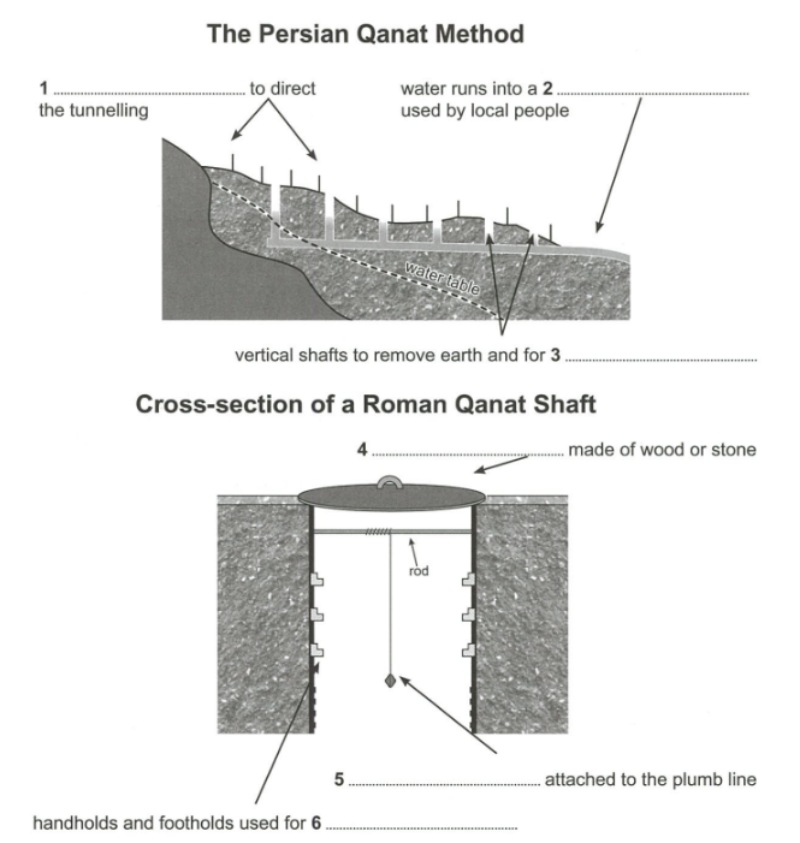Roman tunnels là bài đọc xuất hiện trong Đề Cam 16, Test 4, Reading passage 1. Tại bài viết dưới đây, hãy cùng Edmicro xem qua đáp án cũng như giải thích đáp án cho từng câu:
Đề bài
Roman tunnels
The Romans, who once controlled areas of Europe, North Africa and Asia Minor, adopted the construction techniques of other civilizations to build tunnels in their territories.
The Persians, who lived in present-day Iran, were one of the first civilizations to build tunnels that provided a reliable supply of water to human settlements in dry areas. In the early first millennium BCE, they introduced the qanat method of tunnel construction, which consisted of placing posts over a hill in a straight line, to ensure that the tunnel kept to its route, and then digging vertical shafts down into the ground at regular intervals. Underground, workers removed the earth from between the ends of the shafts, creating a tunnel. The excavated soil was taken up to the surface using the shafts, which also provided ventilation during the work. Once the tunnel was completed, it allowed water to flow from the top of a hillside down towards a canal, which supplied water for human use. Remarkably, some qanats built by the Persians 2,700 years ago are still in use today.
They later passed on their knowledge to the Romans, who also used the qanat method to construct water-supply tunnels for agriculture. Roman qanat tunnels were constructed with vertical shafts dug at intervals of between 30 and 60 meters. The shafts were equipped with handholds and footholds to help those climbing in and out of them and were covered with a wooden or stone lid. To ensure that the shafts were vertical, Romans hung a plumb line from a rod placed across the top of each shaft and made sure that the weight at the end of it hung in the center of the shaft. Plumb lines were also used to measure the depth of the shaft and to determine the slope of the tunnel. The 5.6-kilometer-long Claudius tunnel, built in 41 CE to drain the Fucine Lake in central Italy, had shafts that were up to 122 meters deep, took 11 years to build and involved approximately 30,000 workers.
By the 6th century BCE, a second method of tunnel construction appeared called the counter- excavation method, in which the tunnel was constructed from both ends. It was used to cut through high mountains when the qanat method was not a practical alternative. This method required greater planning and advanced knowledge of surveying, mathematics and geometry as both ends of a tunnel had to meet correctly at the center of the mountain. Adjustments to the direction of the tunnel also had to be made whenever builders encountered geological problems or when it deviated from its set path. They constantly checked the tunnel’s advancing direction, for example, by looking back at the light that penetrated through the tunnel mouth, and made corrections whenever necessary. Large deviations could happen, and they could result in one end of the tunnel not being usable. An inscription written on the side of a 428-meter tunnel, built by the Romans as part of the Saldae aqueduct system in modern-day Algeria, describes how the two teams of builders missed each other in the mountain and how the later construction of a lateral link between both corridors corrected the initial error.
The Romans dug tunnels for their roads using the counter-excavation method, whenever they encountered obstacles such as hills or mountains that were too high for roads to pass over. An example is the 37-meter-long, 6-meter-high, Furlo Pass Tunnel built in Italy in 69-79 CE. Remarkably, a modern road still uses this tunnel today. Tunnels were also built for mineral extraction. Miners would locate a mineral vein and then pursue it with shafts and tunnels underground. Traces of such tunnels used to mine gold can still be found at the Dolaucothi mines in Wales. When the sole purpose of a tunnel was mineral extraction, construction required less planning, as the tunnel route was determined by the mineral vein.
Roman tunnel projects were carefully planned and carried out. The length of time it took to construct a tunnel depended on the method being used and the type of rock being excavated. The qanat construction method was usually faster than the counter-excavation method as it was more straightforward. This was because the mountain could be excavated not only from the tunnel mouths but also from shafts. The type of rock could also influence construction times. When the rock was hard, the Romans employed a technique called fire quenching which consisted of heating the rock with fire, and then suddenly cooling it with cold water so that it would crack. Progress through hard rock could be very slow, and it was not uncommon for tunnels to take years, if not decades, to be built. Construction marks left on a Roman tunnel in Bologna show that the rate of advance through solid rock was 30 centimeters per day. In contrast, the rate of advance of the Claudius tunnel can be calculated at 1.4 meters per day. Most tunnels had inscriptions showing the names of patrons who ordered construction and sometimes the name of the architect. For example, the 1.4-kilometer Çevlik tunnel in Turkey, built to divert the floodwater threatening the harbor of the ancient city of Seleuceia Pieria, had inscriptions on the entrance, still visible today, that also indicate that the tunnel was started in 69 CE and was completed in 81 CE.
Questions 1-6
Label the diagrams below.
Choose ONE WORD ONLY from the passage for each answer.
Write your answers in boxes 1-6 on your answer sheet.
The Persian Qanat Method

Questions 7-10
Do the following statements agree with the information given in Reading Passage 1?
In boxes 7-10 on your answer sheet, write
| TRUE | if the statement agrees with the information |
| FALSE | if the statement contradicts the information |
| NOT GIVEN | if there is no information on this |
7. The counter-excavation method completely replaced the qanat method in the 6th century BCE.
8. Only experienced builders were employed to construct a tunnel using the counter- excavation method.
9. The information about a problem that occurred during the construction of the Saldae aqueduct system was found in an ancient book.
10. The mistake made by the builders of the Saldae aqueduct system was that the two parts of the tunnel failed to meet.
Questions 11-13
Answer the questions below.
Choose NO MORE THAN TWO WORDS from the passage for each answer.
Write your answers in boxes 11-13 on your answer sheet.
11. What type of mineral were the Dolaucothi mines in Wales built to extract?
12. In addition to the patron, whose name might be carved onto a tunnel?
13. What part of Seleucia Pieria was the Çevlik tunnel built to protect?
Đáp án đề Roman tunnels
Các bạn hãy cùng kiểm tra bài làm đề Roman tunnels của mình với đáp án dưới đây của Edmicro nhé!

| Câu hỏi | Đáp án |
|---|---|
| 1 | posts |
| 2 | canal |
| 3 | ventilation |
| 4 | lid |
| 5 | weight |
| 6 | climbing |
| 7 | FALSE |
| 8 | NOT GIVEN |
| 9 | FALSE |
| 10 | TRUE |
| 11 | gold |
| 12 | architect |
| 13 | harbor |
Xem thêm: Saving Bugs To Find New Drugs: Hướng Dẫn Giải Chi Tiết
Giải thích đáp án chi tiết đề Roman tunnels
Dưới đây là giải thích chi tiết cho đề Roman tunnels:
Question 1 – 6
- Question 1
Đáp án: posts
Loại câu hỏi: Diagram Completion
Vị trí đáp án: Đoạn 2, Dòng 3-7
Giải thích đáp án: “In the early first millennium BCE, they introduced the qanat method of tunnel construction, which consisted of placing posts over a hill in a straight line, to ensure that the tunnel kept to its route, and then digging vertical shafts down into the ground at regular intervals.” Điều này giải thích sơ đồ cách các cọc (posts) được đặt theo một đường thẳng trên ngọn đồi để chỉ đạo việc đào đường hầm sao cho đúng lộ trình.
- Question 2
Đáp án: canal
Loại câu hỏi: Diagram Completion
Vị trí đáp án: Đoạn 2, Dòng 10-11
Giải thích đáp án: “Sau khi đường hầm hoàn thành, nước sẽ chảy từ đỉnh đồi xuống kênh đào, cung cấp nước cho con người sử dụng”. Câu trích dẫn cho thấy rằng khi đường hầm hoàn thành, nước sẽ được sử dụng để con người tiêu thụ bằng cách cung cấp nước từ đỉnh đồi và dẫn nước vào kênh đào như trong hình.
- Question 3
Đáp án: ventilation
Loại câu hỏi: Diagram Completion
Vị trí đáp án: Đoạn 2, Dòng 8-9
Giải thích đáp án: “Đất đào được đưa lên bề mặt bằng các trục, điều này cũng giúp thông gió trong quá trình làm việc.” Điều này cho thấy các trục thẳng đứng đã được sử dụng để loại bỏ đất và điều này cũng giúp thông gió khi đất được nâng lên bề mặt.
- Question 4
Đáp án: lid
Loại câu hỏi: Diagram Completion
Vị trí đáp án: Đoạn 3, Dòng 4-6
Giải thích đáp án: “Các hầm được trang bị chỗ bám tay và chỗ bám chân để giúp người ta trèo vào và trèo ra khỏi hầm và được đậy bằng nắp gỗ hoặc đá”. Điều này cho thấy nắp được thể hiện trong hình, được dùng làm vật che hầm, được làm bằng gỗ hoặc đá.
- Question 5
Đáp án: weight
Loại câu hỏi: Diagram Completion
Vị trí đáp án: Đoạn 3, Dòng 6-8
Giải thích đáp án: “Để đảm bảo các trục thẳng đứng, người La Mã treo một dây dọi từ một thanh đặt ngang qua đỉnh của mỗi trục và đảm bảo rằng vật nặng ở đầu dây được treo ở chính giữa trục”. Điều này cho thấy rằng vật nặng được treo từ dây dọi gắn vào thanh đặt ngang qua đỉnh của trục để giữ cho các trục thẳng đứng.
- Question 6
Đáp án: climbing
Loại câu hỏi: Diagram Completion
Vị trí đáp án: Đoạn 3, Dòng 4-6
Giải thích đáp án: “Các hầm được trang bị chỗ bám tay và chỗ bám chân để hỗ trợ người leo vào và ra khỏi hầm và được đậy bằng nắp gỗ hoặc đá”. Điều này cho thấy chỗ bám tay và chỗ bám chân giúp ích cho việc leo qua hầm.

Xem thêm: Stadiums Past Present And Future – Đáp Án Và Giải Thích Chi Tiết
Question 7 – 10
- Question 7
Đáp án: False
Loại câu hỏi: True/False/Not Given
Vị trí đáp án: Đoạn 4, Dòng 1-4
Giải thích đáp án: “Vào thế kỷ thứ 6 trước Công nguyên, một phương pháp xây dựng đường hầm thứ hai xuất hiện được gọi là counter-excavation , trong đó đường hầm được xây dựng từ cả hai đầu. Nó được sử dụng để cắt qua những ngọn núi cao khi phương pháp qanat không phải là một giải pháp thay thế thực tế.” Điều này cho thấy phương pháp đào ngược được sử dụng bất cứ khi nào phương pháp qanat không thực tế và do đó, sẽ không đúng khi nói rằng nó đã hoàn toàn xóa sổ phương pháp qanat.
- Question 8
Đáp án: Not Given
Loại câu hỏi: True/False/Not Given
Vị trí đáp án: N/A
Giải thích đáp án: Mặc dù có đề cập đến phương pháp này đòi hỏi phải lập kế hoạch kỹ lưỡng hơn và có kiến thức chuyên sâu về khảo sát, toán học và hình học, nhưng không có đoạn văn nào nêu rằng chỉ những người thợ xây có kinh nghiệm mới được thuê để xây dựng đường hầm bằng phương pháp đào ngược (counter-excavation method).
- Question 9
Đáp án: False
Loại câu hỏi: True/False/Not Given
Vị trí đáp án: Đoạn 4, Dòng 12-17
Giải thích đáp án: “Một dòng chữ khắc trên một bên đường hầm dài 428 mét do người La Mã xây dựng như một phần của hệ thống cống dẫn nước Saldae ở Algeria ngày nay, mô tả cách hai nhóm thợ xây đã đi lạc nhau trên núi và cách xây dựng sau đó một đường liên kết ngang giữa hai hành lang đã sửa lỗi ban đầu”. Điều này cho thấy thông tin được viết trên một dòng chữ khắc trên bên đường hầm chứ không phải trên sách.
- Question 10
Đáp án: True
Loại câu hỏi: True/False/Not Given
Vị trí đáp án: Đoạn 4, Dòng 12-17
Giải thích đáp án: “Một dòng chữ khắc trên một bên đường hầm dài 428 mét do người La Mã xây dựng như một phần của hệ thống cống dẫn nước Saldae ở Algeria ngày nay, mô tả cách hai nhóm thợ xây đã đi lạc nhau trên núi và cách xây dựng sau đó một đường liên kết ngang giữa cả hai hành lang đã khắc phục được lỗi ban đầu”. Câu này cho thấy rằng ban đầu hai phần của đường hầm không có bất kỳ liên kết nào và không gặp nhau trên núi..
Câu 11 – 13
- Question 11
Đáp án: gold
Loại câu hỏi: Short Answer question
Vị trí đáp án: Đoạn 5, Dòng 7-8
Giải thích đáp án: “Dấu vết của những đường hầm như vậy được sử dụng để khai thác vàng vẫn có thể được tìm thấy tại các mỏ Dolaucothi ở Wales.” Điều này cho thấy khoáng sản được khai thác bằng những đường hầm như vậy như các mỏ Dolaucothi ở Wales chính là vàng.
- Question 12
Đáp án: architect’s name
Loại câu hỏi: Short Answer question
Vị trí đáp án: Đoạn 6, Dòng 15-16
Giải thích đáp án: “Hầu hết các đường hầm đều có dòng chữ ghi tên những người bảo trợ đã ra lệnh xây dựng và đôi khi là tên của kiến trúc sư.” Điều này cho thấy rằng bên cạnh tên của những người bảo trợ, các đường hầm còn có tên của kiến trúc sư được khắc trên đó.
- Question 13
Đáp án: the harbour/ harbour
Loại câu hỏi: Short Answer question
Vị trí đáp án: Đoạn 6, Dòng 16-20
Giải thích đáp án: “Ví dụ, đường hầm Cevlik dài 1,4 km ở Thổ Nhĩ Kỳ, được xây dựng để chuyển hướng dòng nước lũ đe dọa bến cảng của thành phố cổ Seleuceia Pieria, có những dòng chữ khắc ở lối vào, vẫn còn nhìn thấy được cho đến ngày nay, cũng chỉ ra rằng đường hầm này được khởi công vào năm 69 SCN và hoàn thành vào năm 81 SCN.” Điều này cho thấy đường hầm Cevlik được xây dựng để bảo vệ bến cảng của thành phố Seleuceia Pieria.
Trên đây là bài mẫu gợi ý cho đề Roman tunnels Đề Cam 16, Test 4, Reading Passage 1 được đội ngũ chuyên môn tại Edmicro biên soạn. Hy vọng bài viết trên sẽ giúp ích cho các bạn trong quá trình Edmicro IELTS tại nhà.
Xem thêm:











